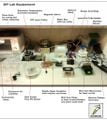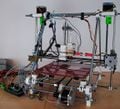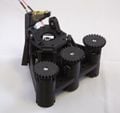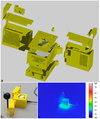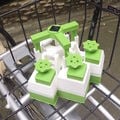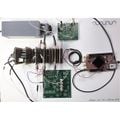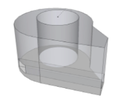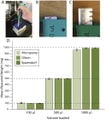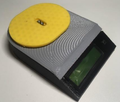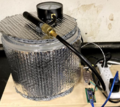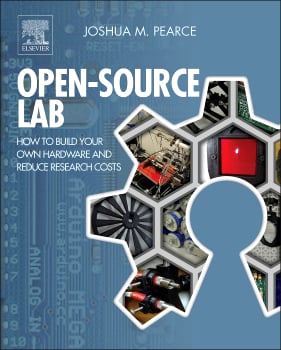
Open-Source Lab, 1st Edition: How to Build Your Own Hardware and Reduce Research Costs
- written by Appropedia user J.M. Pearce
- J.M. Pearce, Open-Source Lab: How to Build Your Own Hardware and Reduce Research Costs, Elsevier, 2013.
- ISBN: 9780124104624
- http://store.elsevier.com/Open-Source-Lab/Joshua-Pearce/isbn-9780124104624/
- 2016 Open source lab equipment interview on Radio New Zealand - Ogg,MP3
- Elsevier has made this chapter freely available for one year, until November 20, 2020: Open-Source Lab: How to Build Your Own Hardware and Reduce Research Costs.
Free content[edit | edit source]
This guide details the development of the free and open-source hardware revolution and provides you with step-by-step instructions on building your own laboratory hardware.
In the first two chapters displayed here, the author defines the basic terms of open-source software and discusses the rise of the open-source hardware revolution and how it impacts science before exploring five pragmatic advantages to joining the open-source scientific community for both your research in general, and most importantly, your equipment and instrumentation.
Key Features[edit | edit source]
- Numerous examples of technologies and the open-source user and developer communities that support them
- Instructions on how to take advantage of digital design sharing
- Explanations of Arduinos and RepRaps for scientific use
- A detailed guide to open-source hardware licenses and basic principles of intellectual property
Description[edit | edit source]
Open-Source Lab: How to Build Your Own Hardware and Reduce Scientific Research Costs details the development of the free and open-source hardware revolution. The combination of open-source 3D printing and open-source microcontrollers running on free software enables scientists, engineers, and lab personnel in every discipline to develop powerful research tools at unprecedented low costs.
After reading Open-Source Lab, you will be able to:
- Lower equipment costs by making your own hardware
- Build open-source hardware for scientific research
- Actively participate in a community in which scientific results are more easily replicated and cited
Examples[edit | edit source]
See also graphical abstract gallery of HardwareX
Open source scientific hardware is open source hardware used by scientists to do research or for education. This gallery and associated sub-pages are an extension of the book the Open Source Lab, which is about how to make scientific equipment following open source principles.
-
The Open-source Lab: How to Build Your Own Hardware and Reduce Research Costs
-
NIH 3D Print Exchange - 3D-printable Custom Labware
-
3D printable science equipment - 3D print your lab
-
3D printable science equipment page 2 - more 3D prints for your lab
-
3D printable science equipment page 3 - and even more
-
Open Source Optics Library - and your optics lab
-
Michigan Tech's Open Sustainability Technology Lab's efforts in open source hardware
-
Open-source syringe pump - Parametric library of web-controlled open-source syringe pumps
-
GaudiLabs- Swiss Fab Lab making low cost lab instruments
-
OpenTrons - Open source fluid handling
-
Plasmatron - OpenTrons derivative for semi-automated culture of malaria parasites
-
IOrodeo - company making open source science instruments
-
Cambridge JIC - 3D printable programmable digital microscope
-
Open Source Imaging, NMR, MRI, EMF
-
Open Behavior FOSH for animal behavior and cognition
-
Openly Published Environmental Sensing Lab at OSU- rain catchment, wind vane, soil moisture, etc.
-
Arduino - a class of open source microcontrollers useful for automating equipment
-
Raspberry Pi - credit-card sized computer running Linux
-
Red Pitaya - open source measurement and control tool
-
OpenLabTools - University of Cambridge initiative in open source hardware for science
-
Tekla Lab - Berkley's initiative for a library of open source DIY quality scientific lab equipment
-
Sensorica - an Open Value Network providing sensing and automation solutions.
-
Hackteria - webplatform and collection of Open Source Biological Art Projects
-
Open Solar Outdoors Test Field - Solar photovoltaic testing
-
Open Source Physiology Lab- 3D printing physiology equipment
-
open ephys works on open-source electrophysiology
-
Backyard Brains - neuroscience experiment kits for DIY electrophysiology
- DSTat - OS potentiostat
Table of Contents[edit | edit source]
Preface
- Introduction to Open-Source Hardware for Science
- The Benefits of Sharing - Nice Guys and Girls Do Finish First
- Open Licensing - Advanced Sharing
- Open-Source Microcontrollers for Science: How to Use, Design Automated Equipment with, and Troubleshoot
- RepRap for Science: How to Use, Design, and Troubleshoot the Self-Replicating 3-D Printer
- Digital Designs and Scientific Hardware
- OpenSCAD, RepRap, and Arduino Microcontrollers
- Physics: Open-Source Optics
- Engineering: Open-Source Laser Welder, Radiation Detection, and Oscilloscopes
- Environmental Science: Open-Source Colorimeter and pH Meter
- Biology: OpenPCR, Open-Source Centrifuges and More
- Chemistry: Open-Source Spectrometers and Other Chemical Research Tools
- The Future of Open-Source Hardware and Science
See also[edit | edit source]
- Quantifying the Value of Open Source Hardware Development
- Return on Investment for Open Source Hardware Development
- Building research equipment with free, open-source hardware
- Open-source colorimeter
- Open-source 3D-printable optics equipment
- Open source science
- Open source 3-D printing of OSAT
- Category:Open source optics
- Free and open-source automated 3-D microscope
- Open-source hardware
- Belt-Driven Open Source Circuit Mill Using Low-Cost 3-D Printer Components
- Open-source hardware for science in Ecuador
- The Rise of Platinum Open Access Journals with both Impact Factors and Zero Article Processing Charges
- Professors Want to Share: Preliminary Survey Results on Establishing Open Source Endowed Professorships
- Canadian professors' views on establishing open source endowed professorships
- Equitable Research Capacity Towards the Sustainable Development Goals: The Case for Open Science Hardware
- Towards open source patents: Semi-automated open hardware certification from MediaWiki websites
- Overcoming Chip Shortages: Low-cost Open-source Parametric 3-D Printable Solderless SOIC to DIP Breakout Adapters
- Open-source 3-D printing materials database generator
External Links with Open Hardware for Science[edit | edit source]
- Open Source Toolkit Channel on PLOS One
- Tekla Labs - Tekla Labs is creating a library of open source DIY (do-it-yourself) documents that guide in the construction of quality lab equipment.
- Open Source Physiology Lab - this site is devoted to the collaboration and development of 3D printing physiology equipment
- Open Lab Tools - U. of Cambridge - created open source microscope prototype that cost around US$800, whereas conventional microscopes cost between US$15,000 and US$80,000[1]
- Open Neuroscience
- Backyard Brains micromanipulator
- MyMiniFactory 3D printable Lab Equipment
- Sensorica
- Hackteria and more specific on Generic Laboratory Infrastructure
- Gnome X Scanning Microscopy
- Open Selective Plane Illumination Microscopy (SPIM)
- 3D printed scientific equipment in Africa- "TReND in Africa" (Teaching and Research in Neuroscience for Development) is a higher education charity dedicated to improving university level science education and research in sub-Saharan Africa.
- DIYBioprinter
- 50 Cent origami microscope
- open-ephys - open-source electrophysiology
- smart phone to microscope with inexpensive lens
- Nature Methods editorial on OSH
- Labrigger - Labrigger is a source for open solutions for research. Their goal is to accelerate and enable research by reducing the duplication of effort by multiple labs, and offering alternatives to expensive lab equipment.
- Klavins lab open-source mixture controlled turbidostat - University of Washington synthetic biology
- From Jim Haseloff lab:
- SafeCast
- CamBridgeSens
- NIH's 3d printable category for custom scientific labware
- Smoky Mountain Scientific - develops and sells modular, Low cost, open-source instrumentation for electrochemistry, fluidics, and datalogging
- From Gongkai to Open Source - Bunnie studios blog on Chinese views of IP
- Experimenting with open science: Open source in the field and in the lab - Free E-book at Opensource.com
- Open Neuroscience
- openMicroanalysis is a community-driven open source project quantitative electron microanalysis. See: discussion forum. Its goals are to:
- centralize physical quantity databases and algorithms used for quantification
- encourage collaborative work
- provide the necessary building blocks for new projects in microanalysis
- https://open.nasa.gov/ (only software now)
- OS Rodent Operant Bucket
- PLOS Blog - with good list of OS toolkits
- Open and Collaborative Science in Development
- The Cave Pearl Project -uses easy to build Arduino data loggers for hydrology research
- Warwick Open Source Microscope: http://wosmic.org/
- Baden and Chagas' collection at PLOS: http://collections.plos.org/open-source-toolkit-hardware
- OpenFlexure Microscope documented at http://docubricks.com/
- Institute for Development of Advanced Applied Systems and https://github.com/IRNAS/OpenSourceLabEquipment
- Metafluidics - Metafluidics was built to provide a home for digital design files and all of the other information necessary to reproduce or remix a microfluidic device.
- UBORA - The Biomedical engineering open design platform
- Lab on the Cheap
- Australian Centre of Excellence - clip on smartphone 3DP microscope [2]
- Our Sci
Supporting publications and examples in the peer-reviewed literature[edit | edit source]
Now there are even journals fully dedicated to open hardware:
- HardwareX - Elsevier (started 2016). See HardwareX Gallery on Appropedia
- Journal of Open Hardware- Ubiquity Press starting 2017
Pearce Group[edit | edit source]
- Pearce, Joshua M. 2012. Building Research Equipment with Free, Open-Source Hardware. Science 337 (6100): 1303–1304. DOI: 10.1126/science.1228183
- Pearce, J.M. (2015) Quantifying the Value of Open Source Hardware Development. Modern Economy, 6, 1-11. doi: 10.4236/me.2015.61001.Free open access to the full text
- Joshua M. Pearce. (2015) Return on Investment for Open Source Hardware Development. Science and Public Policy. DOI:10.1093/scipol/scv034 open access
- Pearce, Joshua M. 2013. Free Innovation Accelerator, Analytical Scientist, Issue #1113, Article #303, December 17th, 2013.
- Pearce, J.M., 2014. Laboratory equipment: Cut costs with open-source hardware. Nature 505, 618. doi:10.1038/505618d
- Joshua M. Pearce "Bone replacements and heart monitors spur health revolution in open source 3D printing" The Conversation, Feb 28, 2014. Reprinted: Live Science
- Joshua Pearce Benjamin Franklin would be proud: hundreds of open-source hardware designs for scientific equipment proliferate - SciTech Connect, June 9, 2014.
- J.M. Pearce, "Commentary: Open-source hardware for research and education", Physics Today 66(11), 8 (2013); doi: 10.1063/PT.3.2160
- J.M. Pearce, 3D-printing your lab equipment—it's cheaper than you think - Elsevier Connect, 2013.
- Zhang C, Anzalone NC, Faria RP, Pearce JM (2013) Open-Source 3D-Printable Optics Equipment. PLoS ONE 8(3): e59840. doi:10.1371/journal.pone.0059840 open access
- Anzalone GC, Glover AG, Pearce JM. Open-Source Colorimeter. Sensors. 2013; 13(4):5338-5346. doi:10.3390/s130405338 open access
- Joshua M. Pearce, Share, and We All Grow Richer, The Analytical Scientist, Issue #0213, Article #301 (2013).
- Bas Wijnen, Emily J. Hunt, Gerald C. Anzalone, Joshua M. Pearce, 2014. Open-source Syringe Pump Library, PLoS ONE 9(9): e107216. doi:10.1371/journal.pone.0107216 open access
- Joshua Pearce, Guest Blog: Circumventing Science Lab Budget Cuts with Open-Source Hardware. Sparkfun Education Blog. January 23, 2015. Joshua Pearce on Open Hardware for Education --Oomlout
- Joshua M. Pearce. Buckle up for fast-tracked science thanks to open-source hardware. Engineering for Change. June 8, 2015.
- Joshua M. Pearce. Science for All: How to Make Free, Open Source Laboratory Hardware, Scientific American Blog. Dec. 4, 2015.
- Karankumar C. Dhankani, Joshua M. Pearce. Open Source Laboratory Sample Rotator Mixer and Shaker. HardwareX 1, pp.1-12 (2017). doi:j.ohx.2016.07.001 open access
- Oberloier, S. and Pearce, J.M. General Design Procedure for Free and Open-Source Hardware for Scientific Equipment. Designs 2018, 2(1), 2; doi:10.3390/designs2010002 open access
Open Source Scientific Hardware Companies[edit | edit source]
| Organisation | URL | Type of Org | Category/Discipline |
|---|---|---|---|
| Adafruit | https://www.adafruit.com/ | company | sensors and electronics |
| airgradient | https://www.airgradient.com/ | company | environment |
| Arribada | https://arribada.org | company | conservation |
| Backyard Brains | https://backyardbrains.com | company | neuroscience |
| Bristlemouth | https://www.bristlemouth.org/ | open standard, housed by a company | oceanography |
| Conservify | http://conservify.org | non-profit | conservation |
| Electric Blue | https://electricblue.eu/about-us | cooperative | environmental monitoring, biologging |
| EmbryoPhenomics | https://www.embryophenomics.org/ | research group but setting up a company | embryonic development in aquatic animals |
| EnviroDIY | https://www.envirodiy.org/shop/ | non-profit | environment |
| flyPAD | https://flypad.rocks | company | animal behaviour (drosophila) |
| Gaudilabs | https://gaudishop.ch/index.php/product-category/open-science-hardware/ | company | biology |
| IO Rodeo | https://iorodeo.com | company | electrochemistry & biochemistry |
| IRNAS | https://www.irnas.eu/ | company | open science hardware consulting |
| Manetco srl | https://www.manetco.be/ | company | open science hardware consulting |
| Neuro Tinker | https://open-neuroscience.com/post/neurotinker/ | project | neuroscience |
| Open Acoustic Devices | https://www.openacousticdevices.info | company | acoustics |
| Open ePhys | https://open-ephys.org | project with company? | neuroscience |
| OpenBCI | https://openbci.com | company | neuroscience |
| OpenFlexure Industries | https://openflexure.org | company | microscopy |
| OpenQCM | https://openqcm.com/ | company | QCM |
| OpenROV | https://www.kickstarter.com/projects/openrov/openrov-trident-an-underwater-drone-for-everyone | oceonography | |
| OpenTrons | https://opentrons.com/ | company | lab automation |
| OptArc | https://www.optarc.co.uk/ | company | microscopy |
| Pocket Science Lab | https://pslab.io/ | project with company? | (environmental) sensors |
| Prometheus Science | https://www.prometheus-science.com | company | open science hardware consulting |
| Public Lab | https://publiclab.org | non-profit | environment |
| RedPitaya | https://redpitaya.com/ | company | open science instruments |
| Safecast | https://safecast.org | non-profit | environment |
| Sanworks | https://sanworks.io/ | company | neuroscience |
| Sci-Bots | https://sci-bots.com/ | company | microfluidics |
| Seeed | https://www.seeedstudio.com/contacts | company | sensors and electronics |
| Smart Citizen Kit | https://smartcitizen.me/ | sold via Seeed Studio | environment |
| Spark Fun | https://www.sparkfun.com/ | company | sensors and electronics |
| Tympan | https://shop.tympan.org | company | hearing aids |
| UC2 | https://openuc2.com/ | company | microscopy |
| Upside Down Labs | https://store.upsidedownlabs.tech/ | company | neuroscience |
| Libre Solar | https://libre.solar | company | electronics for renewable energy systems |

















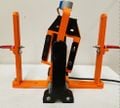






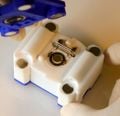

![Flypi - Portable device for microscopy, thermo and optogenetic experiments [1]](/w/images/thumb/4/4a/Flypi.png/109px-Flypi.png)

